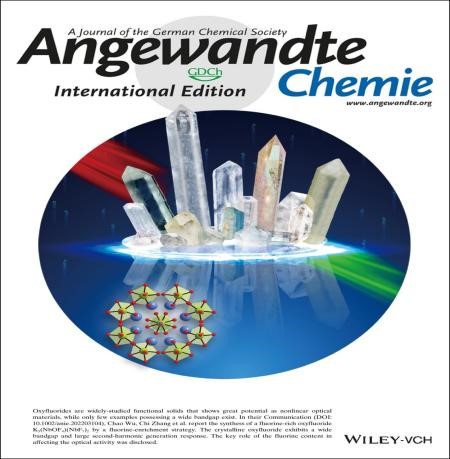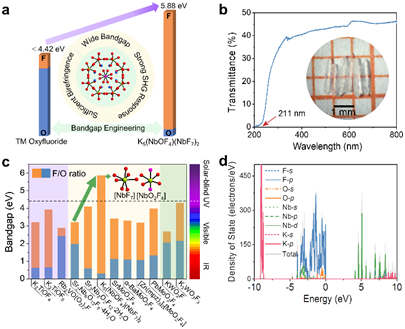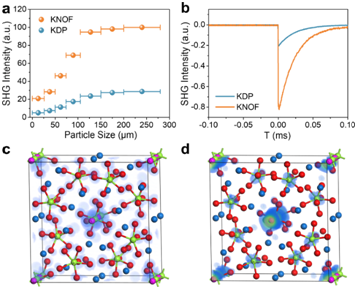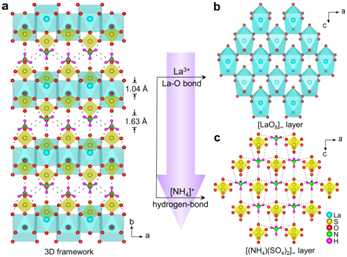Deep UV and solar blind UV nonlinear optical crystal materials have important applications in laser technology, medical diagnosis, short wave communication, fire monitoring and laser guidance. At present, the commercialized UV nonlinear optical crystals cannot meet the needs of short-wave UV frequency conversion due to their structural defects or phase mismatches. This has hindered the development of modern laser crystal technology and its application in high and new technology. It presents huge challenges to do research on and develop UV nonlinear optical crystal materials that can be used in UV and deep UV bands with excellent performance, especially those with large second-order nonlinear coefficient, wide band gap and matched phase.

The research results by ZHANG’s research team
as cover article of German Applied Chemistry
The research team of Academician ZHANG Chi from the School of Chemical Science and Engineering of our university focused their research on oxyfluoride and designed a solar blind UV nonlinear optical crystal material K5 (Nb0F4) (NbF7)2 (KNOF) with wide band gap and strong frequency doubling response. They proposed a molecular design strategy for enriching highly electronegative fluorine anions to regulate the energy band structure. Their research findings were published in a paper entitled “Ultrawide Bandgap and Outstanding Second-Harmonic Generation Response by a Fluorine Enrichment Strategy at a Transition-Metal Oxyfluoride Nonlinear Optical Material” in the international edition of Applied Chemistry (Angewandte Chemie 2022, e202203104) in Germen on May 17, and was selected as the cover article by the Editorial Committee of Angewandte Chemie (Angewandte Chemie Int. ed., 2022, e202206423).
In this research, the researchers proposed, for the first time, the molecular design strategy of enriching fluorine anions to regulate the energy band structure, created a transition metal oxyfluoride KNOF with a fluorine oxygen ratio of 18:1 in the molecular structure, and discussed the important effects of the transition metal central oxyfluoride polyhedron on the structure, band gap and second harmonic properties of crystalline materials. In view of molecular structure, a high fluorine oxygen ratio is beneficial to eliminate the disorder of oxygen and fluorine in the transition metal central polyhedron, which leads to the long-range ordered arrangement of the transition metal central polyhedron and promotes the formation of non-central symmetric structure. Based on optical properties of materials, the unsubstituted oxygen atoms in the transition metal central polyhedron can be used as a structure directing agent to make the transition metal central polyhedron preferentially polarize in the same direction and induce the molecular system to produce strong frequency doubling response. Since the main contribution of the top of the valence band of the material comes from the fluorine 2p electron orbital, when the oxygen position in the central polyhedron of the transition metal is partially or even completely replaced by fluorine ions with higher electronegativity, the top of the valence band will move to the lower energy, resulting in the widening of the band gap.

Molecular design strategy of enriching fluorine anions to regulate the energy band structure proposed for the first time by ZHANG’s research team
Through single crystal X-ray diffraction structure analysis, ZHANG’s research team revealed the influence mechanism of [Nb02F4] and [NBF7] metal niobium central polyhedron in the KNOF molecular structure on the linear and second-order nonlinear optical properties of the material. The fluorine anion acts as a chemical “scissors”, making the structure composed of a one-dimensional [NbO2F4] ∞ chain and a separated [NbF7] polyhedron, thus effectively reducing the dimension of the structure. Affected by the second-order ginger Taylor effect, niobium cations form partially fluorinated [NbO2F4] octahedron and completely fluorinated [NbF7] polyhedron. These distorted polyhedrons are aligned along the c-axis, which is conducive to large frequency doubling effect. In the Nb centered polyhedron, increasing the ratio of fluorine to oxygen can restrain the top of the valence band dominated by the 2p electron orbital of oxygen from moving to the high energy. The fluorine oxygen ratio in KNOF is much higher than that of other transition metal oxyfluorides. This fluorine rich environment not only weakens the interaction between niobium cations and oxygen in [NbO2F4] groups, but also promotes the formation of orderly and completely fluorinated [NbF7] groups. These two fluorine rich groups broaden the transparent range of UV light. The research team also applied the first principle theory to simulate calculation, clarified the internal physical mechanism that KNOF can achieve strong frequency doubling effect and wide band gap at the same time, and explained that the main reason for the strong frequency doubling effect is the orderly arrangement of highly distorted partially fluorinated [NbO2F4] and fully fluorinated [NbF7F4] polyhedrons, The wide band gap comes from the highly fluorinated transition metal central polyhedron in the material structure. The inorganic crystal KNOF has both a wide optical band gap (5.88 eV, corresponding to the 211 nm solar blind UV region at the UV absorption cut-off edge) and a strong frequency doubling response (4.0 × KH2PO4@1064 nm), and moderate birefringence (0.07 @546 nm).This study provides a new research and design idea for exploring the second-order nonlinear optical crystal materials with short wave ultraviolet transmission.

This study reveals the influence mechanism of [NbO2F4] and [NbF7] metal niobium central polyhedrons rich in extreme fluorine anions
in the KNOF molecular structure on the linear and second-order nonlinear optical properties of the materials
Recently, the research team also took non π - conjugated sulfate as the research object, proposed a composite cationic salt strategy, and developed a rare earth sulfate deep UV second-order nonlinear optical crystalline material with strong frequency doubling effect. The research results were published in a paper entitled “A Lanthanum Ammonium Sulfate Double Salt with a Strong SHG Response and Wide Deep-UV Transparency” online in German Applied Chemistry (Angew. Chem. Int. ed., 2022, 61 (6), e202115855).

A compound cationic salt strategy proposed with non π - conjugated sulfate as the research object
The above research has been supported by the key projects of the National Natural Science Foundation of China, the Innovation Team of the Ministry of Education (MOE), the Innovation Team in the Ministry of Science and Technology, the discipline innovation plan of colleges and universities of MOE-State Administration of Foreign Experts, and the key projects of the scientific innovation plan of Shanghai Education Commission. ZHANG Chi is the corresponding author of the paper, WU Tianhui, a doctoral candidate of the School of Chemistry, and associate professor WU Chao are the authors of the paper. Professor HUANG Zhipeng participated in the research work.
Cover page and links to the two papers:
https://onlinelibrary.wiley.com/doi/10.1002/anie.202206423
https://onlinelibrary.wiley.com/doi/10.1002/anie.202203104
https://onlinelibrary.wiley.com/doi/10.1002/anie.202115855